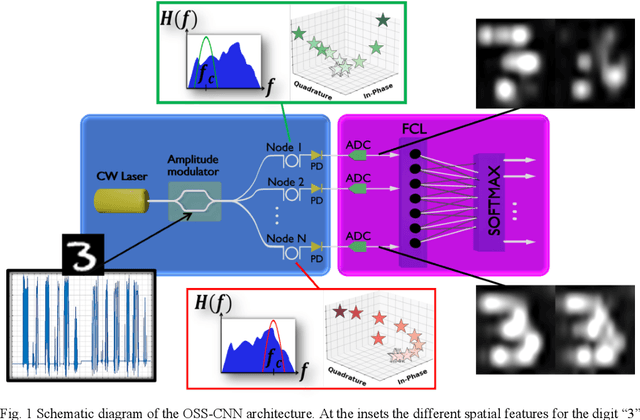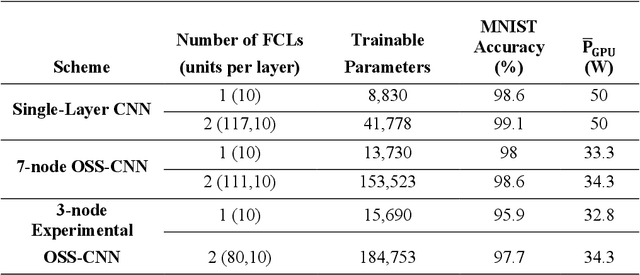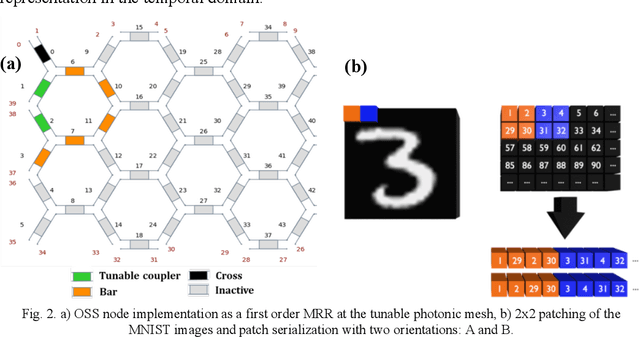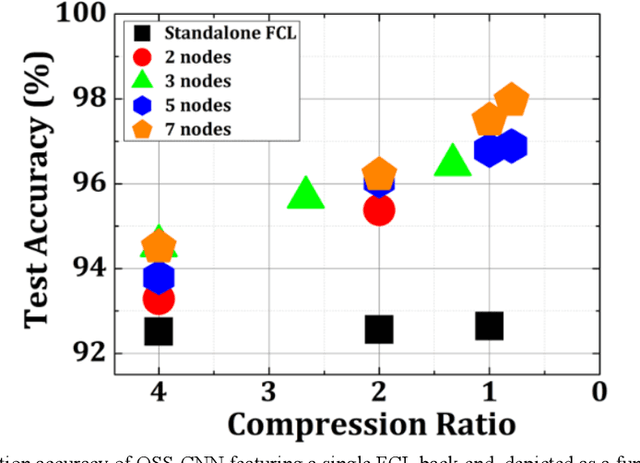Aris Tsirigotis
Photonic Neuromorphic Accelerator for Convolutional Neural Networks based on an Integrated Reconfigurable Mesh
May 10, 2024



Abstract:In this work, we present and experimentally validate a passive photonic-integrated neuromorphic accelerator that uses a hardware-friendly optical spectrum slicing technique through a reconfigurable silicon photonic mesh. The proposed scheme acts as an analogue convolutional engine, enabling information preprocessing in the optical domain, dimensionality reduction and extraction of spatio-temporal features. Numerical results demonstrate that utilizing only 7 passive photonic nodes, critical modules of a digital convolutional neural network can be replaced. As a result, a 98.6% accuracy on the MNIST dataset was achieved, with a power consumption reduction of at least 26% compared to digital CNNs. Experimental results confirm these findings, achieving 97.7% accuracy with only 3 passive nodes.
Photonic Neuromorphic Accelerators for Event-Based Imaging Flow Cytometry
Apr 16, 2024Abstract:In this work, we present experimental results of a high-speed label-free imaging cytometry system that seamlessly merges the high-capturing rate and data sparsity of an event-based CMOS camera with lightweight photonic neuromorphic processing. This combination offers high classification accuracy and a massive reduction in the number of trainable parameters of the digital machine-learning back-end. The photonic neuromorphic accelerator is based on a hardware-friendly passive optical spectrum slicing technique that is able to extract meaningful features from the generated spike-trains. The experimental scenario comprises the discrimination of artificial polymethyl methacrylate calibrated beads, having different diameters, flowing at a mean speed of 0.01m/sec. Classification accuracy, using only lightweight, digital machine-learning schemes has topped at 98.2%. On the other hand, by experimentally pre-processing the raw spike data through the proposed photonic neuromorphic spectrum slicer we achieved an accuracy of 98.6%. This performance was accompanied by a reduction in the number of trainable parameters at the classification back-end by a factor ranging from 8 to 22, depending on the configuration of the digital neural network.
Integrated Photonic Accelerator Based on Optical Spectrum Slicing for Convolutional Neural Networks
Mar 18, 2023



Abstract:In this work we numerically analyze a passive photonic integrated neuromorphic accelerator based on hardware-friendly optical spectrum slicing nodes. The proposed scheme can act as a fully analogue convolutional layer, preprocessing information directly in the optical domain. The proposed scheme allows the extraction of meaningful spatio-temporal features from the incoming data, thus when used prior to a simple fully connected digital single layer network it can boost performance with negligible power consumption. Numerical simulations using the MNIST dataset confirmed the acceleration properties of the proposed scheme, where 10 neuromorphic nodes can replace the convolutional layers of a sophisticated LeNet-5 network, thus reducing the number of total floating point operations per second (FLOPS) by 98% while offering a 97.2% classification accuracy.
 Add to Chrome
Add to Chrome Add to Firefox
Add to Firefox Add to Edge
Add to Edge